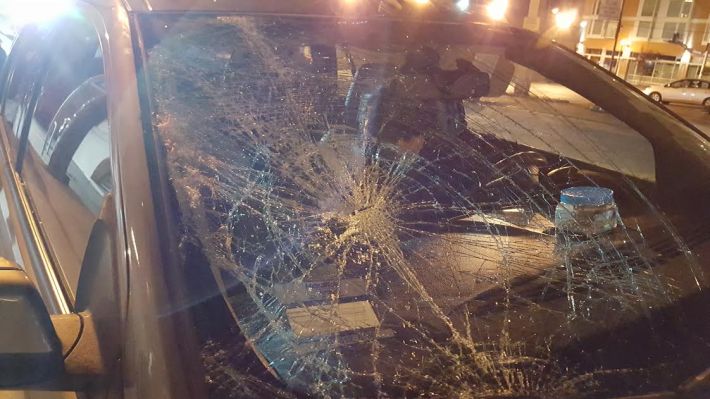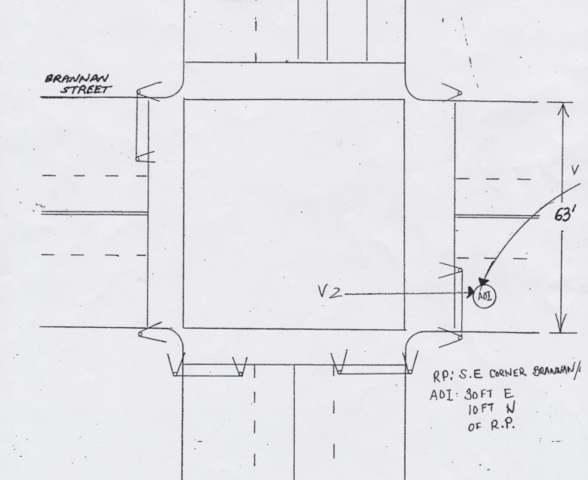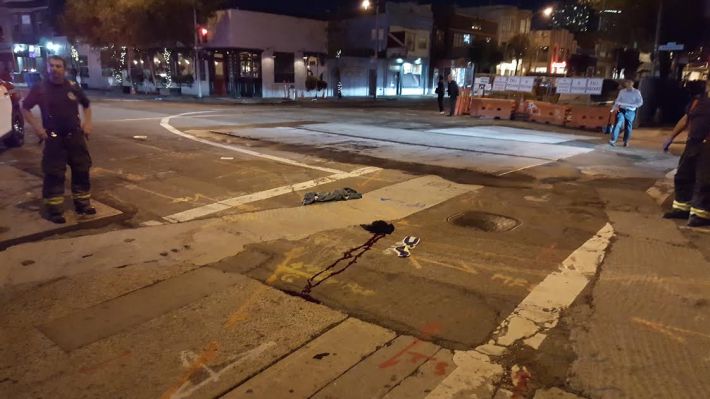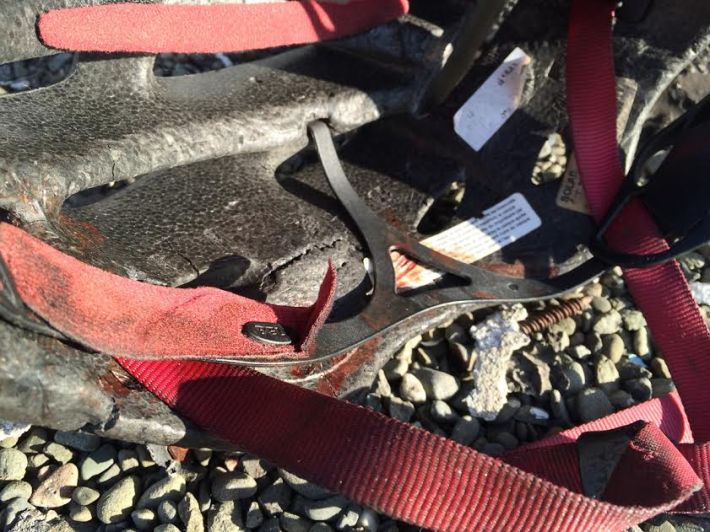
Justin Liszanckie was running an errand on the evening of July 20. "I was on Brannan and heading west, trying to turn south on Fourth towards the ballpark," he said. And that's the last thing he remembers until "waking up in the hospital hours later."
Liszanckie ended up in San Francisco General for ten days. His injuries: "Three broken bones around the orbit of my right eye. Extensive lacerations on the right side of my face and ear. A fourth fracture in my right side nasal bone. Two broken vertebrae on the right side of neck, two broken ribs, a broken right pelvis."
But all in all, he feels somewhat lucky to have avoided any surgeries. "Once I was out, I made sure I had follow up appointments...mostly I was concerned about the facial fractures around my eye." Again, he was lucky. His eye is okay.
But something else happened in the hospital he hadn't anticipated.
He got a traffic citation for $238.
The police never came to the hospital to interview him. The ticket is based on the testimony of a driver who was waiting to cross, the driver of the vehicle that struck Liszanckie, and her passenger.
Liszanckie, frustrated, and still in pain from his crash, reached out to Streetsblog:
I've been a daily cyclist in SF for about eight years and was recently severely injured when a car ran me over at 4th & Brannan. I spent 10 days in SF General and am in the midst of three months on disability, yet shockingly the police cited me...despite numerous inconsistencies from those involved/witnesses, clear driver negligence, and the basic laws of physics. The officer also showed a shocking lack of interest in trying to obtain additional evidence such as video footage which was mentioned in the police report but never sought out.
I would obviously love to help bring more pressure on the SFPD to rectify the anti-cyclist bias that I and countless others have felt in the last decade, especially as ridership has exploded.
Liszanckie sent a copy of the collision report to Streetsblog. The driver of the car that hit him, according to the report, said she "never saw the bicyclist until her vehicle made contact with him." The officer cited Liszanckie for crossing the yellow line, but it's difficult to see how he reached that conclusion.
Liszanckie went onto the hood of the car and hit the windshield, and then fell forward, landing in the crosswalk. But crossing the yellow line would have put Liszanckie behind the crosswalk at the time of the collision (see diagram below). For him to land where he did, Liszanckie's momentum would have had to be sufficient to move the Silver Ford Eagle backwards. As Liszanckie said, "the police cited me...despite numerous inconsistencies from those involved/witnesses, clear driver negligence, and the basic laws of physics."
Remember, the policeman didn't see the crash. The only witnesses he spoke to were the driver who hit Liszanckie, the passenger, and a neutral witness in another car. The driver said she didn't see him until she hit him. The passenger also wasn't looking.
As to the neutral witness, Streetsblog reached out to him directly and scheduled a phone interview. The witness, however, didn't answer his phone. Streetsblog will keep trying and update this post. However, going by an email exchange Liszanckie had with the witness, the police report doesn't correspond:
I was stopped on the red light on 4th and Brannan intersection, heading southwards on 4th. I was on the very left lane possible due to construction to travel cross Brannan, when light turned green for me I've noticed Ford SUV ... [the car that hit Liszanckie] crossing intersection from the Brannan side traveling eastwards, in the rough speed of 45 mph + , if not more than that [in other words, the SUV had either run a solid red or entered the intersection as it transitioned from yellow to red]
Going through the report, Streetsblog can only conclude the following: Liszanckie was hovering in the intersection, waiting to make his left turn. The SUV either pushed the yellow or blew through a recently turned but solid red light as he started his turn. Furthermore, if the police report of her testimony is correct, the driver of the SUV could not have been paying full attention to the road.
And yes, Liszanckie had an operating headlight.

"We don't exactly know what happened. Our big beef with a case like this is the officer. Officers typically are very black and white and simplistic about how a collision happens," said Michael Stephenson, an attorney with Bay Area Bicycle Law, who is helping Liszanckie with the case.
As he puts it, collisions usually are caused by two people fouling up.
"A cyclist might have made an illegal turn against a red, but a driver might also have failed to keep a proper look out, or made an illegal entrance--usually two things go wrong. We think Justin didn't actually run the red. We seem to have found a witness who thinks the driver ran a red. So the officer concluded that Justin made an illegal turn across the double yellow line?"


Stephenson said police officers are often responding to ten or more collisions a day, in addition to their usual duties. As a result, investigations get rushed. Nobody questions more than one or two witnesses. In the case of car-on-cyclist collisions, the driver of the car is usually unharmed. The cyclists, if they survive, are usually discombobulated and in agony, or unconscious. Often, the driver will collect contact information from witnesses--but only those that are favorable to the driver's version of what happened. Those witnesses then end up in court.
Furthermore, "unless you've got video or a witness who decides to come forward, usually the officer is only talking to someone who is blaming the cyclist--mainly, the driver," said Stephenson.
And the police report remarked that there were cameras from a nearby bank looking at the intersection. "There is a Wells Fargo and a Bank of America on opposite corner. I wrote a letter, but neither will turn over video" said Liszanckie. "The most infuriating part of this to me is the police officer made a note that there's a bank, there's a Wells Fargo and they might have video evidence. But that was it. Nobody followed up."
Streetsblog reached out to the San Francisco Bicycle Coalition to find out if this sounds typical for how the SFPD handles car-versus-bicycle collisions.
They referred us to the case of Emily Claymore, who was hit while leaving Golden Gate Park on May 16, 2015. "I was cited for going against the flow of traffic which I wasn't doing," she said, a fact that was easily confirmed by the angle of her injuries. In the end, she beat the citation in appellate court--the conclusion was that the driver had failed to yield. The SFPD eventually relented, and attributed the officer's "unwarranted action" in citing her as a "training failure."
But it took some very heavy lifting by Claymore and some dedicated advocates and public servants, including a police captain. "SFBC put me in touch with D1 Supervisor Eric Mar who contacted the captain of the Richmond Police Station (then it was Captain Silverman)," said Claymore. "The Captain then rode the route I took, and asked the ticketing officer to dismiss the citation he issued me as the Captain did not believe I was to blame. The officer refused." That was eventually resolved in court.
And, sadly, who can forget the case of Amelie Le Moullac, who was killed by a truck that ran her over in the bike lane. Advocates, not the police, had to find the surveillance video in that case too.
So where does this leave cyclists?
It's a pretty grim situation that screams that cyclists simply must have video cameras lashed onto their bikes and helmets. Depending on luck isn't a good strategy. Streetsblog readers will recall the case of Tim Doyle, who was riding in the bike lane when an SFPD cruiser jinked into it, putting him in the hospital. Imagine how that would have played out if not for a good Samaritan motorist with a dash cam?
Stephenson also recommends that cyclists, if they are hit, make sure to collect and save evidence. He remembers a case where a cyclist was about to throw out a jacket from a crash. But that jacket turned out to be a key piece of evidence in winning a case against a motorist who claimed the cyclist suddenly swerved out of the bike lane and into his path. "We found the smallest little spec of paint on the client's left elbow of his jacket, from his landing on the bike lane paint," said Stephenson. That proved the cyclist was in the bike lane and the car had swerved into him, not the other way around.

Stephenson also recommends that cyclist don't have any expectation that the police are going to do a complete investigation. To the extent that an injured cyclist is able, get names of all witnesses. Or call a loved one or a friend and ask them to do it. His biggest policy recommendation is to change the expectations when police investigate crashes. Police should be encouraged to write "I don't think I have enough facts to render a conclusion," he said, when they are investigating a crash.
Getting back to Liszanckie, he's now thinking about getting a camera. "I've had a couple of minor dust-ups over the past eight years, but I've never had anything nearly this dangerous or dramatic or this kind of serious," he said. "It never really dawned on me that I might need a GoPro as a way to protect myself."
Still, overall, he feels lucky. "I'm back to walking pretty well. Still feel like I'm dealing with issues from the concussion--my face still feels broken, my pelvis is still healing from a break, and I have a number of other kinds of joint bruises and soreness," he said, but, "on the whole, I'm alive and not paralyzed."




